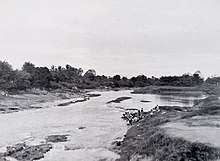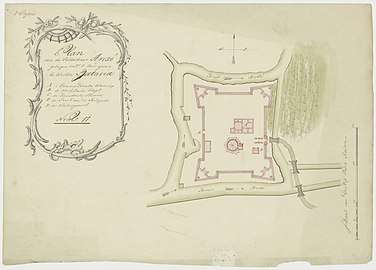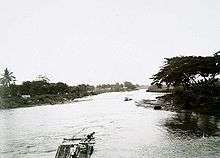Mookervaart River
Mookervaart River (Mookervaart Canal; also written in Indonesian as Mokervart) is a canal connecting the Cisadane River in Tangerang and Kali Angke (Angke River) in Jakarta.[1][2] Constructed from 1678 to 1689, this 25-30 meter wide channel is one of the important flood control water channels in Jakarta.[3]
| Mookervaart River Mookervaart Canal, Sungai Mokervart | |
|---|---|
 Mookervaart River ("K. Mookervaart"), upper left in the map of rivers and canals of Jakarta (2012) | |
| Native name | Kali Mookervaart, Sungai Mookervaart |
| Location | |
| Country | Indonesia |
| State | Jakarta |
| Physical characteristics | |
| Source | |
| • location | Cisadane |
| • coordinates | 6°10′04″S 106°38′06″E |
| Mouth | Angke River |
• coordinates | 6°09′36″S 106°46′00″E |
| Length | 13 km (8.1 mi) |
History

The Mookervaart was originally constructed in 1678 to 1689 to draw one third the water flow from Cisadane river, and link to the city canals of Batavia, to control the flood.[3] In 1732 Governor General Diederik Durven ordered the canal to be dug deeper to bring more water to the city, but this created stagnant pools that brought deathly illness, such as malaria, increasing the mortality.[4] Furthermore, the canal also swells very high during the rainy season, so a lock was built at the upper end of the river in 1770.[5] Nonetheless, the Mookervaart still supplies the most water to Batavia in 18th century.[5]
Hydrology
Mookervaart river has a length of 13 kilometres (8.1 mi), with the watershed area (Indonesian: Daerah Pengaliran Sungai) of 67 km².[6] The average daily rainfall is 132 mm, with the peak debit at 125 m³.[6]
Geography
The river flows in the northwest area of Java with predominantly tropical rainforest climate (designated as Af in the Köppen-Geiger climate classification).[7] The annual average temperature in the area is 27 °C. The warmest month is March, when the average temperature is around 30 °C, and the coldest is May, at 26 °C.[8] The average annual rainfall is 3674 mm. The wettest month is December, with an average of 456 mm rainfall, and the driest is September, with 87 mm rainfall.[9]
Historic place
Fort Anké was built by the Dutch East India Company in 1657[10] at the intersection of the Mookervaart channel (Mookervaart river) and Angke river.[11] Historical names for the fort include: Anckee, Anke, Ankee.[12]
 Map of Fort Anké
Map of Fort Anké Map of the Anké entrenchment
Map of the Anké entrenchment
See also
References
- Mookervaart - Mapcarta.
- Mookervaart - Geonames.org.
- Jan Kop, Wim Ravesteijn, Kasper Kop. Irrigation Revisited: An anthology of Indonesian-Dutch cooperation 1965-2014. Eburon Uitgeverij B.V., 2015. pp. 307-309. ISBN 9789463010283
- R.J. Ross, Gerard J. Telkamp (eds). Colonial Cities: Essays on Urbanism in a Colonial Context. Volume 5 of Comparative Studies in Overseas History. Springer Science & Business Media, 2012. ISBN 9789400961197
- Stockdale, John Joseph. Sketches, Civil and Military, of the Island of Java and Its Immediate Dependencies, Comprising Interesting Details of Batavia, and Authentic Particulars of the Celebrated Poison-tree Harvard University, 1811. pp 221-222.
- BBWS Ciliwung Cisadane. Pengendalian Banjir dan Perbaikan Sungai Ciliwung Cisadane (PBPS CC). Archived in Konservasi DAS Ciliwung - April 2012.
- Peel, M C; Finlayson, B L; McMahon, T A (2007). "Updated world map of the Köppen-Geiger climate classification". Hydrology and Earth System Sciences. 11. doi:10.5194/hess-11-1633-2007.
- "NASA Earth Observations Data Set Index". NASA. 30 January 2016.
- "NASA Earth Observations: Rainfall (1 month - TRMM)". NASA/Tropical Rainfall Monitoring Mission. 30 January 2016.
- "Angke, Fort" (in Indonesian). Jakarta City Administration. Archived from the original on November 7, 2016. Retrieved July 6, 2011.
- "Vijfhoek Redoute". Jakarta Encyclopedia. Department of Communication, Informatics and Public Relations of Jakarta Capital City. 1995–2012. Archived from the original on August 8, 2014. Retrieved August 1, 2014.
- "Anckee". Atlas of Mutual Heritage. AMH. 2014. Retrieved August 1, 2014.
